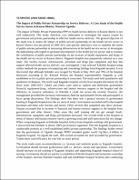| dc.description.abstract | TUMWINE (2010-MO83-10046)
The Impact of Public-Private Partnership on Service Delivery: A Case Study of the Health Service Sector in Kasese District, Western Uganda.
The impact of Public-Private Partnership (PPP) in health service delivery in Kasese district is not well understood. This study, therefore, was undertaken to investigate the impact caused by government and private partnership in effective health service delivery. The general objective of the study was to assess the impact of public-private partnership on the health service sector in Kasese district over the period of 2006-2012 and specific objectives were to establish the extent of public-private partnership in increasing infrastructure in the health service sector; to investigate the undertaking with regard to personnel development in the health service sector; and to examine the contribution of public-private partnership on the increase of health equipments and drugs in the health service sector in Kasese district. Kagando hospital was purposively selected as a case study. The facility income, infrastructure, personnel and drugs plus equipment and how this support affected health service delivery was investigated. I also selected Kilembe hospital using similar methods for purposes of comparing and contrasting findings from Kagando hospital. It was discovered that although Kilembe was ravaged by floods in May 2013 and 70% of the hospital destroyed according to Dr. Edward Wefura the hospital superintendent, Kagando is well established as far as public-private partnership is concerned. The study used both quantitative and qualitative techniques. The study used Kagando hospital records from hospital documents for the fiscal years 2006-2012. Tables and charts were used to analyse and determine government financial, equipment/drugs, infrastructure and human resource support to the hospital and the efficiency in resource utilisation. In Kilembe I could not access the records; however, the management provided the necessary information, filed the questionnaire forms and participated in focus group discussions. The findings show that there was a general increase in government funding to Kagando hospital over the six years of study. Government-seconded staff to the hospital increased and these were doctors and nurses. Other services like outpatient also show increase. Outputs increased due to increase in financial and human resource support to the hospital from government and other donors. Other areas like staff training did not get enough funds. Infrastructure, equipment and drugs procurement increased. The overall trend of the hospital in terms of finance and human resource shows a growing trend and staff motivation did not change. When comparing Kagando to Kilembe hospital, both private hospitals working with government, I discovered that Kilembe is almost 100% government supported. This left Kagando hospital in a comfortable position as a well-established public-private partnership. The findings further reveal that the government of Uganda through PPPH extended grants worth Ug.Shs.1.4 billion to Kagando hospital. As regards the staff, 18% overall accounted for staff seconded by government. Trends show staff efficiency for over the six years period.
The study made some recommendations i.e. increase and maintain grants to Kagando hospital. Government should increase professional staff i.e. doctors, nurses and specialists. Government should increase on-job training of Kagando hospital and supporting Kagando hospital school of nursing. Government should act quickly to rehabilitate Kilembe hospital and harmonise ownership of the hospital. Increase Kilembe hospital staff and rehabilitate hospital facilities plus conducting
a study to establish the cause of the floods in Kilembe. The government should compensate the nurses and doctors who lost their property during the May 2013 floods.
Key Words: Public-Private Partnership, Service Delivery, Health Service Sector, Kasese District. | en_US |


